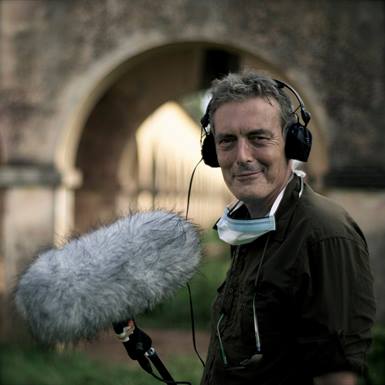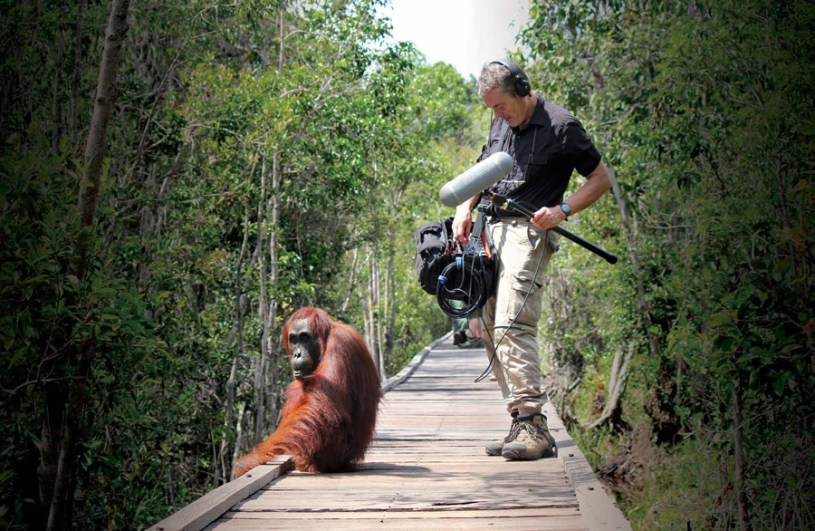Craig Carter.
The late Craig Carter, who died in 2017, was regarded one of Australia’s most distinguished sound designers.
As a designer, recordist and editor, Carter worked on more than 100 productions, winning multiple AFI Awards, including best sound (with collaborators) for Rabbit-Proof Fence, The Lighthorsemen, Ground Zero and Malcolm.
Throughout his career he recorded an extensive range of sound effects and atmospheres, which up until recently sat on a series of hard drives.
With permission from Craig’s wife Fiona, his brother-in-law James Harvey and Niels Gabriels – both fellow sound designers – have spent the last few months curating a catalogue that encapsulates the best of Carter’s recordings.
The total 190GB collection, which spans 3,870 wav files and more than 10,000 sounds, is now available to the independent sound community. Various libraries include apes, chimpanzees and gorillas; Australia; industrial; hospitals; prisons; maritime; schools; wind; trains, and insects.
We speak to Gabriels about the process of compiling the collection.
How did the Craig Carter Collection come about?
The Craig Carter Collection originated on a field recording trip into the Australian bushland for The True History of the Kelly Gang. Sound designers Frank Lipson and Andrew Neil needed additional recordings of the wilderness in order to create a uniquely Australian soundscape. In the midst of this sound recording expedition, the late Craig Carter came up in conversation over an unexceptional cup of rural café coffee. Andrew mentioned that Craig’s life work was currently archived on numerous hard-drives, likely to malfunction at any moment. It was suggested that I get in contact with his brother-in-law and sound designer, James Harvey, whom I’ve worked with on numerous films. James was nothing but excited at the idea of releasing Craig’s extensive collection to the independent sound effects community. The idea of creating a legacy for Craig and having sound designers around the world use his sounds was one that both James and Craig’s wife, Fiona Carter, agreed was worthwhile. And so, the process began.
Why did you want to make Craig’s recordings available?

The idea of creating and releasing the Craig Carter Collection to the independent sound effects community essentially originated from the fear of hard-drives ageing, malfunctioning and ultimately losing the data that Craig accumulated over his 34-year career. A number of the 19 original hard drives containing the raw sound files had already malfunctioned, and so it was a race against time to create backups and begin the process of organising, editing and preparing the collection for release. Considering my engagement in the independent sound effects community since 2015, both as a consumer and vendor, James was confident in my ability to catalogue such an extensive collection of sounds. With the existing platform of Edible Audio, in place in addition to good relations with the owner of asoundeffect, Asbjoern Anderson, we were confident that the Craig Carter Collection would receive the recognition it deserved upon release.
What did the process of compiling the collection involve, and how long did it take?
The process of compiling the Craig Carter Collection was one that James and I worked part-time on for five months, balancing the immense workload between our freelance projects, personal lives and sleep. James undertook the initial role of examining the original hard drives and selecting material that was suitable for inclusion. James was familiar with Craig’s unconventional method of naming and organising files, meaning that without him this endeavour would have never eventuated. Between the months of January and April, James and I would regularly meet up for coffee, using this time to transfer files and discuss the content that needed to be prepared. Subsequent to this initial stage of categorisation, it was my responsibility to bring the raw recordings into ProTools and edit them accordingly. This involved removing any of Craig’s comments, microphone bumps, unwanted frequencies, pops, clicks and lastly adding crucial metadata. Lastly, I applied a coherent naming convention and structured the collection so that it is logical to external sound designers.
Can you describe the breadth of recordings in the collection? What are the highlights for you?
Craig Carter had a unique eagerness to record the natural world, always carrying his recording equipment with him wherever he went. This enthusiasm for sound recording shows in the Craig Carter Collection through the extensive range of sounds included. The foremost highlight for me is undoubtedly the Australia collection. Having lived in Australia for 20 years, I am continuously amazed by the unique soundscapes of this land, from dawn chorus in the bush to the eerie quietude of the Australian outback. Craig has managed to capture an extensive body of work ranging from the outback, rural farmlands, bushland, billabongs, creaks, gorges, Indigenous instruments, lakes and forests. I consider this collection a fundamental addition to the sound effects library of any Australian sound designer.
On reflection, what did compiling the collection reveal to you about Craig and his craft? Did you find anything unexpected in the process?
The extensive range of Carter’s recordings was monumental, with sound effects being recorded from multiple perspectives and atmospheres at multiple times of the day. I frequently heard Craig’s voice through the tags at the start of his recordings; a voice that expressed a sense of passion and delight for the sound recording process. An unexpected discovery was Craig’s Insects library and his comments on microphone placement. Craig’s creativity shined in the recording of this collection ingeniously placing microphones to capture unique perspectives and nuances. Over the course of assembling the Craig Carter Collection it became clear that sound recording was a lifelong undertaking for Craig. A continuous process of learning, exploring and collecting.
Did you know Craig personally? If so, are there any fond memories of him you’d like to share?
Unfortunately, I did not have a chance to meet Craig as our time as sound designers did not overlap. Throughout this endeavour I did however, managed to spend a bit of time with Craig’s brother-in-law, James Harvey, who spoke fondly of his memories with Craig and the projects on which they collaborated. With an underlying chuckle, James described Craig as the kind of person that would have no hesitation in asking a construction crew to keep it down so that he could record sounds.
The Craig Carter Collection is accessible through asoundeffect, the largest independent sound effects library website. Learn more about the collections’ libraries here, and listen to samples here.


